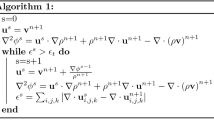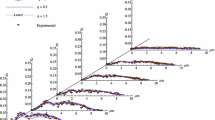Abstract
Heat and mass transfer in a gas-droplet spray is investigated numerically using the Eulerian description of both phases. The system of averaged equations for the dispersed phase is based on the kinetic equation for the probability density function of the particle coordinates, velocity, and temperature. With increase in the particle concentration and size, the spray becomes narrower and longer. However, for evaporating sprays, particularly with small droplets, the turbulence suppression and mixing effects are less pronounced than for jets without phase transitions. The strongest turbulence suppression is detected in the initial spray region, where the droplet concentration is maximum and the droplet size is only slightly reduced due to vaporization.
Similar content being viewed by others
References
N.A. Chigier, “The Atomization and Burning of Liquid Fuel Sprays,” Prog. Energy Combust. Sci. 2(2), 97–114 (1976).
S.K. Aggarwal, A.Y. Tong, and W.A. Siringano, “A Comparison of Vaporization Models in Spray Calculations,” AIAA J. 22(10), 1448–1457 (1984).
G.M. Faeth, “Mixing, Transport and Combustion in Sprays,” Prog. Energy Combust. Sci. 13(4), 293–345 (1987).
A.H. Lefebre, Atomization and Sprays (Hemisphere, New York, 1989).
W.A. Siringano, “Fluid Dynamics of Sprays—1992 Freeman Scholar Lecture,” Trans. ASME. J. Fluid Engng. 115(3), 345–378 (1993).
F. Peng and S.K. Aggarwal, “A Review of Droplets Dynamics and Vaporization Modeling for Engineering Calculation,” Trans. ASME. J. Eng. Gas Turbines and Power 117(3), 453–461 (1995).
C.T. Crowe, M.P. Sharma, and D.E. Stock, “The Particle-Source-in-Cell (PSI-Cell) Model for Gas-Droplet Flows,” Trans. ASME. Ser. D. J. Basic Eng. 99(2), 325–332 (1977).
A.S.P. Solomon, J.S. Shuen, Q.F. Zhang, and G.M. Faeth, “Measurements and Predictions of the Structure of Evaporating Sprays,” Trans. ASME. J. Heat Transfer 107(3), 679–686 (1985).
A.A. Mostafa and S.E. Elghobashi, “A Two-Equation Model for Jet Flows with Vaporizing Droplets,” Fluid Dynamics 25(3), 73–78 (1990).
A.A. Mostafa and H.C. Mongia, “On the Modeling of Turbulent Evaporating Sprays: Eulerian versus Lagrangian Approach,” Int. J. Heat Mass Transfer 30(12), 2583–2593 (1987).
A. Berlemont, M.S. Grancher, and G. Gousbet, “Heat and Mass Coupling between Vaporizing Droplets and Turbulence using Lagrangian Approach,” Int. J. Heat Mass Transfer 38(16), 3023–3034 (1995).
Y.V. Zuev and I.A. Lepeshinskii, “Two-Phase Multicomponent Turbulent Jet with Phase Transitions,” Fluid Dynamics 30(5), 750–757 (1995).
X.Q. Chen and J.F.C. Pereira, “Computation of Turbulent Evaporating Spray with Well-Specified Measurements: a Sensitivity Study on Droplet Properties,” Int. J. Heat Mass Transfer 39(3), 441–454 (1996).
M. Sommerfeld, “Analysis of Isothermal and Evaporating Turbulent Sprays by Phase-Doppler Anemometry and Numerical Calculations,” Int. J. Heat Fluid Flow 19(2), 173–186 (1998).
D.I. Kolaitis and M.A. Founti, “A Comparative Study of Numerical Models for Eulerian-Lagrangian Simulations of Turbulent Evaporating Sprays,” J. Heat Fluid Flow 27(3), 424–435 (2006).
M. Sommerfeld, G. Kohnen, and M. Rueger, “Some Open Questions and Inconsistencies of Lagrangian Particle Dispersion Models,” Proc. 9th Int. Symp. on Turbulent Shear Flows (Kyoto, Japan, 1993), Paper 15.1.
E.P. Volkov, L.I. Zaichik, and V.A. Pershukov, Modeling of Solid-Fuel Combustion [in Russian] (Nauka, Moscow, 1994).
I.V. Derevich, “Hydrodynamics and Heat and Mass Transfer of Particles in Turbulent Gas-Particle Tube and Axisymmetric-Jet Flows,” Teplofiz. Vys. Temper. 40(1), 86–99 (2002).
M. Pakhomov, K. Sharov, D. Starodumova, et al. “Experimental and Numerical Simulation of Turbulent Gas-Droplet Evaporating Spray,” Proc. 6th Int. Conf. Multiphase Flow ICMF’2007 (Leipzig, Germany, 2007), CD Rom, Paper No. 232.
C.B. Hwang and C.A. Lin, “Improved Low-Reynolds-Number kɛ-Model Based on Direct Simulation Data,” AIAA J. 36(1), 38–43 (1998).
L. Boguslavskii and C.O. Popiel, “Flow Structure of the Free Round Turbulent Jet in the Initial Region,” J. Fluid Mech. 70 Pt. 3, 531–539 (1979).
N.R. Panchapakesan and J.L. Lumley, “Turbulence Measurements in Axisymmetric Jets of Air and Helium. Pt. 1. Air Jet,” J. Fluid Mech. 246, 197–223 (1993).
T.-W. Kuo and F.V. Bracco, “On the Scaling of Impulsively Started Incompressible Turbulent Round Jet,” Trans. ASME, J. Fluid Eng. 104, 191–197 (1982).
V.I. Terekhov and M.A. Pakhomov, “The Thermal Efficiency of Near-Wall Gas-Droplet Screens. I. Numerical Modeling,” Int. J. Heat Mass Transfer 48(9), 1747–1759 (2005).
S.V. Patankar, Numerical Heat Transfer and Fluid Flow (Hemisphere, New York, 1980).
B.P. Leonard, “A Stable and Accurate Convective Modelling Procedure Based on Quadratic Upstream Interpolation,” Comput. Methods Appl. Mech. Eng. 19(1), 59–98 (1979).
J.P. Van Doormaal and G.D. Raithby, “Enhancements of the SIMPLE Method for Predicting Incompressible Fluid Flow,” Int. J. Numerical Heat Transfer A 7(2), 147–163 (1984).
S.Yu. Krasheninnikov, “Calculation of Axisymmetric Swirling and Non-Swirling Turbulent Jets,” Fluid Dynamics 7(3), (1972).
G. Hestroni and M. Sokolov, “Distribution of Mass, Velocity, and Intensity of Turbulence in a Two-Phase Turbulent Jet,” Trans. ASME. Ser. E. J. Appl. Mech. 38, 315–325 (1971).
M.A. Pakhomov, M.V. Protasov, V.I. Terekhov, et al., “Experimental and Numerical Investigation of Downward Gas-Dispersed Turbulent Pipe Flow,” Int. J. Heat Mass Transfer 50(11–12), 2107–2116 (2007).
H. Reichardt, Gesetzmaessigkeiten der Freien Turbulenz (VDI-Forschungsheft, 1942).
G.N. Abramovich, T.A. Girshovich, S.Yu. Krasheninnikov, et al. Theory of Turbulent Jets [in Russian] (Nauka, Moscow, 1984).
Additional information
Original Russian Text © M.A. Pakhomov, V.I. Terekhov, 2009, published in Izvestiya Rossiiskoi Akademii Nauk, Mekhanika Zhidkosti i Gaza, 2009, Vol. 44, No. 3, pp. 102–113.
Rights and permissions
About this article
Cite this article
Pakhomov, M.A., Terekhov, V.I. Effect of vaporizing droplets on the structure of a submerged spray. Fluid Dyn 44, 419–429 (2009). https://doi.org/10.1134/S0015462809030090
Received:
Published:
Issue Date:
DOI: https://doi.org/10.1134/S0015462809030090




